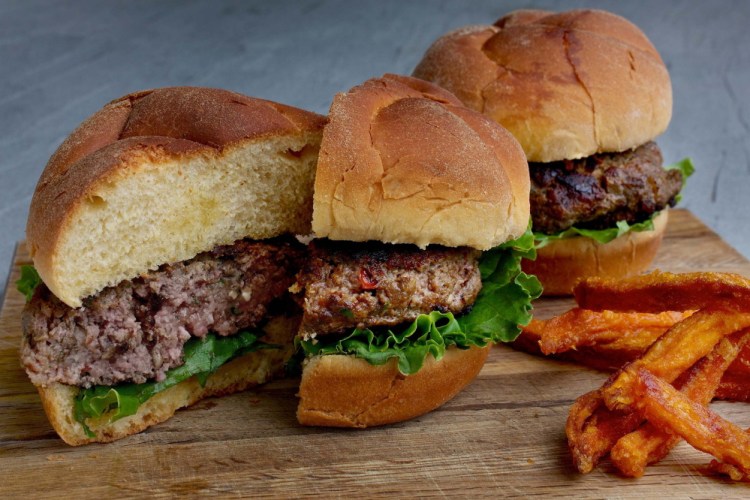If you have a question about mushrooms, Bart Minor is your guy. As the president and chief executive of the Mushroom Council for 16 years, he has a stunning depth of knowledge about edible fungi and an alarming enthusiasm about them.
Minor could talk forever about enokis (did you know they are grown in plastic bottles?), industry sales (a record $1.1 billion for 2012-13 in the United States) or nutrition (mushrooms are the only item in the produce aisle containing vitamin D).
But Minor is particularly excited about what he sees as the latest miracle of mushrooms: their ability to mix with and boost the flavors of ground meat in foods such as burgers and chili, while simultaneously cutting calories, fat and costs. A sensory study funded by the council, to be published in the Journal of Food Science this fall, showed that consumers generally preferred meat-mushroom blends in tacos over a 100 percent beef filling, citing increased aromas, flavors and moisture.
“You can make things healthier by putting broccoli in it. You can make things cheaper by putting soy in it,” Minor says. “This is revolutionary because it’s so simple. It’s meat and mushrooms. They go together like peanut butter and jelly.”
Clearly, Minor has skin in the game. If chefs and restaurant operators see what the industry calls “blendability” as an easy way to serve more-healthful food, his members are going to sell a lot more mushrooms. But then, the man does have a point. In an industry that thrives on giving customers what they want, the best way to get people to improve their diets is to find healthful foods that don’t taste like a sacrifice.
No wonder, then, that the Cheesecake Factory and Seasons 52 restaurant chains recently added meat-mushroom burgers to their menus. Institutions including Yale, Harvard and the University of Southern California use mushrooms in Bolognese sauces, taco fillings and chilies. Compass Group, one of the world’s largest food-service operators, is encouraging its cafes to do the same; more than 300 locations have already signed on.
Mixing meat and mushrooms, Minor admits, is hardly a novel idea. Beef dishes such as Wellington and stroganoff are classics because the pairing with mushrooms is a natural one. But positioning blends as a healthful and more eco-friendly alternative is new.
The evidence is compelling: Substituting mushrooms for just one-quarter of a recipe’s beef content reduces calories, fat and sodium by about a third. Because livestock production and distribution accounts for an estimated 14.5 percent of greenhouse-gas emissions worldwide, eating less meat is also environmentally responsible.
The push for blending started in 2011, when the Mushroom Council, an industry trade group, joined a Culinary Institute of America initiative called the Healthy Menus R&D Collaborative. Participants, which include McDonald’s, Panera, Compass and Cargill, aim to develop practical ways to expand healthful dining choices.
Chefs at the CIA in Napa, Calif., worked to develop recipes that substituted mushrooms for ground beef. At an early tasting, Minor says, the dishes “tasted good, but the texture was wrong.” For a follow-up, chefs quartered button mushrooms, cooked them, then minced them to mimic the texture of ground beef. “That,” he says, “was the aha moment.”
The technique can be applied in any kitchen. Among the most enthusiastic adopters have been school cafeterias. In 2010, Congress passed tougher federal nutrition guidelines governing school meals, and food-service directors have been scrambling to find ways to cut back on calories and fat and to add more vegetables.
With uncharacteristic speed, institutional suppliers brought meat-mushroom patties to the market.
Even though the Mushroom Council study found that consumers preferred a 50-50 blend of beef and mushrooms over the all-beef taco filling, some fine-dining chefs – many of whom have been using that technique for years – say 20 percent mushrooms is about the limit before the dish starts to taste too much of mushrooms.
“At 20 percent, people don’t realize,” Jehangir Mehta, executive chef of Graffiti in New York, says of his signature burger – although the recipe he provided for it uses 6 ounces of mushrooms for 1 pound of beef, or about 27 percent. “It just tastes like a very flavorful burger.”
Dwayne Motley, executive chef of Nage in D.C., agrees that the 80-20 ratio provides the right balance: “It gives you a depth of flavor, but you still taste the meat, the cheese, the garlic, everything.”
To make his Angus Burgers, Motley first makes duxelles, the classic French mixture of mushrooms, aromatics and seasonings; he uses a blend of creminis and portobellos, plus morels when they are in season. He finely chops the mushrooms and cooks the mixture twice to release any remaining liquid. Then he combines it with Parmigiano-Reggiano cheese, Worcestershire sauce, oregano and ground beef. The resulting burgers are served with cheese and a few drops of truffle oil.
Neither Motley nor Mehta says he uses mushrooms to make his food more healthful: That’s just a bonus. And that, says Minor, is the beauty of blendability: “The bottom line is that people in America love burgers. People know they are supposed to eat more fruits and vegetables. If we are actually going to change things for them, we need to improve the things they eat most often.”
Send questions/comments to the editors.



Success. Please wait for the page to reload. If the page does not reload within 5 seconds, please refresh the page.
Enter your email and password to access comments.
Hi, to comment on stories you must . This profile is in addition to your subscription and website login.
Already have a commenting profile? .
Invalid username/password.
Please check your email to confirm and complete your registration.
Only subscribers are eligible to post comments. Please subscribe or login first for digital access. Here’s why.
Use the form below to reset your password. When you've submitted your account email, we will send an email with a reset code.